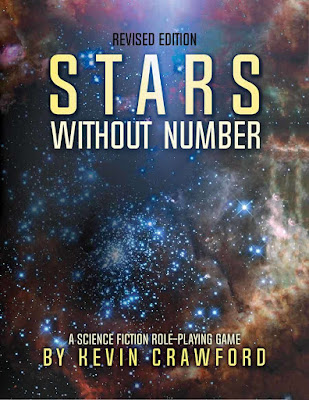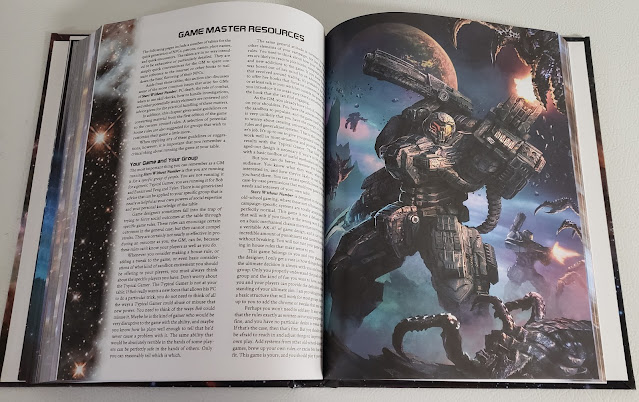The game is beautiful and there is so much going on with it that it would take me a number of games with it just to get the right feeling for it. The overall feel I get with this game is that it is the perfect child of Basic D&D and Traveller. So much of what made both of those games so great is here.
Is Stars Without Number perfect? No, not really. But it is really, really damn close and even from a short distance I could not tell it apart from a perfect game.
Recently I went back over the game and still found it to be nearly perfect. But I had not played it all that much since then.
So on a whim really I picked up the newest Stars Without Number: Revised Edition and I figured I would grab the Print on Demand as well. I just go it in the main this past week.
Wow.
That is really the only way to describe it. Any of the reservations I had about the previous edition evaporated with this edition.
I am considering the PDF and the full-color Print on Demand version.
Written by Kevin Crawford, art by Jeff Brown, Christof Grobelski, Norah Khor, Aaron Lee, Joyce Maureira, Nick Ong, Grzegorz Pedrycz, Tan Ho Sim. And what fantastic art it is too! All pages are full color and each one is evocative and eyecatching. 324 pages.
Chapter 1 covers Character creation. We have seen this all before, but perfect for people new to RPGs or sci-fi fans new to the Classic 6 Attributes and level/class systems. The feel here is solid old-school and SWN:RE wears its old-school and OSR cred proudly. BUT they are also a new game with new design sensibilities. For example, character creation is broken down into easy steps.
You can determine your character's skills (and these can be from a number of sources).There are background packages that can be added to classes to give your character more depth and determine some of their skills. There are also training packages to further define your character.
The classes are the three "archetypes" that you can find in other games, The Expert, The Psychic, and The Warrior. This edition also has The Adventurer which does a little bit of all the above.
Character creation is a breeze and no one seems to die while doing it. There is even a quick character creation method on pages 26-27.
Chapter 2 covers Psionics. Psionics are rather central to the background fiction of the SWN:RE universe, so they get special placement. There are quite a lot of psionic powers detailed here. So first thing, if psionics are something you must have in your sci-fi game then please check this game out first. Psionic points always give the powers a different feel for me than magic, so this is another plus really. These powers are not merely reskinned spells, they have been redone to fit within the mythos of the game better.
Chapter 3 is the Systems chapter. It includes the expected combat, but also a new twist on the skill checks with Target Numbers. Useful if you are using the skills as described here, but its real utility comes in how flexible it can be. I would have to try it out more, but it's close enough to other skill + die roll + mods vs TN that I can see its use in a variety of situations. What I like about these skills is they are a 2d6 roll resolution system and not a d20. Sure makes it feel a little like Traveller. TRhis chapter also covers all sorts of actions, like combat (regular d20 vs AC here) and Saving Throws; Physical, Evasive, and Mental. Hacking also dealt with here since it is most similar to a skill check.
This also covers Character advancement.
Chapter 4 details all the equipment you will need including the Technology Level of the equipment. D&D would be tech level 1 (or so) while we are at TL 3. The game is set at TL 5 with some artifacts at TL 6. Time Lords are hanging out at 7 or 8 I would say. D20 Future and Traveller also use a similar mechanic, so if you want to see how they can also work, checking out those games is advisable.
The standard batch of weapons and armor from sticks and stones all the way up to energy weapons are discussed. AC is now ascending. What is really nice about this game is in addition to lasers, energy swords, and computers it also includes Cyberware, Drones, Vehicles, and "pre-Silence" artifacts.
Chapter 5 gives us Starships. Everything on size, type, and costs to ship-to-ship combat.
Chapter 6 covers the History of Space of the default campaign setting. Even if you don't use it there are some great ideas here.
Chapter 7 is Sector Creation which is just FULL of material for any game. While this game has a lot going for it, this is the real gem in my mind. This chapter is long, detailed and honestly, it makes me want to create worlds.
Chapter 8 covers Adventure Creation. You have characters, you have created all these worlds. Let's get them together.
Chapter 9 is the Xenobestiary. AKA the Monster Manual. Again we are given a lot of detail on how to make alien beasts and then a listing of several samples. Given the old-school nature of this game you could grab ANY old-school monster book for ideas. Yeah...doing Space Orcs could be boring, but Warhammer 40k has been doing them for so long and if you wanted to do them here, well the rules won't stop you. This chapter also covers the creation of alien species. First, the hows and whys of aliens are discussed; what to use, where, and why to use them. Some of this is situated in the campaign setting, but there is some good advice here even if you plan on using your own background/campaign or not even have aliens.
Chapter 10, Factions. Factions are important groups. Say a group of allied pirates or smugglers, a government or a band of plucky rebels. Several key factors when creating a faction are given and there is a huge list of sample factions.
Chapter 11 is Game Master Resources. It talks about character death and when to roll for skills. How to build a galaxy and conversions from First Edition Star Without Number.
Chapter 12 covers newer material, namely Transhuman stories. Or what I call the Altered Carbon chapter. The ability to move on to new bodies.
Chapter 13 has my undivided attention since it is Space Magic. That's right magic and wizards in space. Not psionics, but real arcane magic.
Chapter 14 covers heroic characters. These are not your Traveller grunts or even characters from Star Frontiers, these are your Luke Skywalkers, your Buck Rogers, and more.
Chapter 15 is True Artificial Intelligence.
Chapter 16 covers Societies.
Chapter 17 gives us Mechs.
There is a fantastic Index (sadly lacking in many books).
SWN:RE ups the game in every possible way over SWN:1st Ed.
Print on Demand
I said this book was gorgeous and I meant it. The print-on-demand copy I got is sturdy and heavy. It is also the closest thing I have seen to offset printing in a POD product. You would have to look hard to tell difference.
I described the previous version as "nearly perfect." Reading through this version I am only left to say that is one pretty much is perfect. It does everything a sci-fi game should. I mentally slot different sci-fi stories, tropes, and ideas in while reading through it and I could not find something that didn't have a fit somewhere.
I have read a lot of sci-fi games this month, but this is one of the best.



























